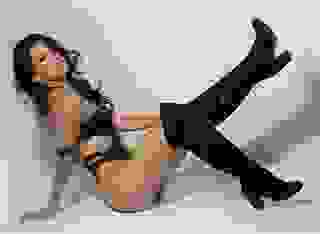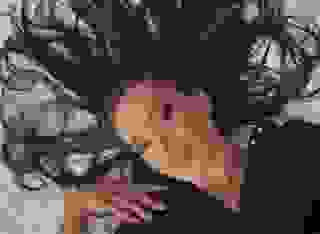- Reviews & Essays
- How to Make a Film on 'Story Of O'
Note: You can change font size, font face, and turn on dark mode by clicking the "A" icon tab in the Story Info Box.
You can temporarily switch back to a Classic Literotica® experience during our ongoing public Beta testing. Please consider leaving feedback on issues you experience or suggest improvements.
Click herel'Histoire d'O (Story of O), the '75 film and an idea
by Vitavie
The Story of O (l'Histoire d'O) - the book
L'Histoire d'O is a book written by Pauline Réage, a woman under a double pseudonym (!), and published in 1954 in France. Note that in France erotica, erotic literature and SM were (and are) relatively openly acceptable. She wrote the story for her lover, a prime publisher, to prove to him that women could write erotica. Well, we know now she was right. She singlehandedly gave course to SM literature; I would say even more so than De Sade and von Sacher-Masoch, who both wrote landmark works. Their works are famous, but not widely read. L'Histoire d'O still resonates seventy years on, because it is still of the times. O is a young woman who has a steady career as an independent fashion photographer. She is given no name, except the single capital 'O', a symbol for Open (Ouvert).
The book chronicles the physical and mental journey that O takes, from being René's vanilla lover, to his submissive, to that of Sir Stephen, to that of the world. Réage vividly gives life to O and focuses on the feelings and thoughts of O, convincingly, and on what drives her. A severe book with a woman as the very credible protagonist, who is being bossed around by that weak figure of René and later the 2D-character of Sir Stephen. Motivated by nothing but love. Perhaps by adventure, but nothing suggests she was born a masochist. In the end O takes the initiative to annihilate herself when Sir S deserts her.
The characters of René and Sir S are flat, sketchy characters, because only necessary to help that of O along. She herself is a credible, warm-bodied and strong character, who displays strength in the vanilla world as a fashion photographer and whose strength in the scene world lies in giving herself up first for Mr. Nobody René and then to a-shallow-God-on-earth Sir S.
There are three significant scenes I want to highlight because they resonate with me, in addition to the well-known scenes of: the shock of her first arrival at Roissy, her being used by manservant Pierre, member of the lowest grade of men at Roissy, her timeless incarceration in that dungeon in the bowels of Roissy, the scene of her first meeting with Sir S, that of her woman-to-woman dallying with model Jacqueline, also quite novel at the time, that of her having been whipped by Nora, the woman of colour who is a servant (and mistress) to Sir S, to scare off the young upstart Ivan/ Eric, that of her being whipped by a peer, another slave and woman, at Anne-Marie's, the scenes where young Nathalie fizzes with enthusiasm to be near and be like O and so on. My three favourite scenes are:
- That, where O is told to shed her morning robe and get nude, before sorting out her clothes into those she cannot wear anymore, as they inhabit access, the majority of her wardrobe that is, and those that do allow access. Then she waits faithfully like a dog for René's arrival home. I like it because it typifies her slavery as having to be sexually accessible anywhere, anytime;
- The scene at the conclusion, where O is left to her own devices at the concluding party given by the Commandeur and is visited by a young couple, where the boy makes the girl touch O's breasts and (a rare depilated) belly, with chain and medallion attached to her labia, and tells the girl he will do this to her too, an exchange where they do not involve O of course - she is an object, not deserving of any attention. The scene typifies all that O is in a nutshell: an object that can be ignored (or used), but that still provides fear and attraction and is a model for how the couple's relationship could be;
- The final little scene, a postscript in the book that can be overlooked, suggests a dual ending, the first of which states that Sir S brings O to Roissy again and deserts her there, the second which states that O sees that Sir S is about to leave her and asks to die instead, which Sir S allows. What this says about Sir S, well, I have my opinion and it is not favourable, but for O it means that she is dedicated to him to the fullest and can't live without him (even if he proves unworthy.)
As to the final item, note that the beginning also has two variants: one) she gets taken to Roissy by René, who does the commanding, gets her to shed her underwear, to not cross her legs and to sit with bare skin on the seat, two) the simpler, cruder variant, where the driver is the one commanding and directing.
Feminists, meanwhile, have disagreed on the quality or the morality of the book, even though it was written by a formidable woman. O may be a victim, a victim of her love first for René and later for Sir S, but to me she is a strong woman. O may be subjected to multiple rape, but she consents. In post-#MeToo times, writing a book like O today would meet with fierce criticism. The crucial idea that saves the book is this: l'Histoire d'O is not a realistic book, but an idealistic dream, a fantasy. Political correctness will have a difficulty there, but that is how it is.
There is a lot more to be said about the book I love, but a lot has been said about it already. You are encouraged to consult Google to your heart's content.
The above serves to enable me to discuss the 70's film(s). Bear with me...
The existing film based on the Story of O (l'Histoire d'O) is disappointing
Why is the 1975 film made after the Story of O (l'Histoire d'O) so disappointing? (I am sure I have missed newer productions. Believe there is a multiple-part mini-series too. I'd like to be proven wrong, in the sense that something good does exist as we speak.) Perhaps I should clarify 'disappointing' and say 'mediocre, insignificant, superficial, false' etc instead. I am referring to the (in-) famous Just Jaeckin (JJ) film. Jaeckin also made the Emmanuele series, this time about an adventurous, initiative taking woman.
The JJ version was groundbreaking, perhaps, as it brought SM into the mainstream, decades before the Fifty Shades of Grey series, and it has its visually appealing moments. Corinne Cléry is a pretty girl, but the film only reflects the essence, the intentions and mood of the book in a very watered-down manner. The film is soft-porn, 'Emmanuelle goes slavegirl.'
Cléry walks through the adventure sufficiently naively, girlishly perhaps, perhaps like O accepting all that is done to her, not resisting, out of love. Yet the mood is all too easy to my mind. I see no evidence of the hardship O experiences - the embarrassment at being given to the Roissy crowd, the deep pain at being brutally beaten, the dedication to Sir S at the expense of her career in fashion and life, the profound embarrassment when Sir S orders her to masturbate in his presence; the book expresses these emotions so well. Nor indeed does the film express the deep joy she feels once she has submitted to Sir S, a joy that is worth more than life itself as it turns out. The frivolous love interest between the manservant Pierre and O in the film is simply ridiculous.
As an example of the opportunities that the film choses to miss, consider the final scene in the book, where O is set down, at the party of the Commandeur, in the corner of the courtyard, like a dog on a leash held by young Nathalie. In the book, the actions of and talk between the young couple that visits O, without involving her of course, typify all that O is in a nutshell: an object that can be ignored (or used), but that still provides fear and attraction and is a model for how that couple's relationship could be, and, by extension that of every couple! In the film this young couple is entirely missing. The same holds for my beloved clothes-sorting scene.
I said that the Story of O-book describes a fantasy, an ideal. It describes a relationship between any woman and man, simply reduced to an extreme form, in this form perhaps not viable or desirable in reality, but all the more recognisable at the end of the day, because of the high contrast. Not so in the film. The film is not about the depths, but about the surface. I call that superficial, shallow. It does not satisfy me. I call it bitterly disappointing, because the book deserves so much better.
Did the Story of O film have to be so mediocre?
Now why would Just Jaeckin's (JJ) film be that way, aesthetically pleasing, but superficial, shallow --- mediocre? Did it have to be, in the year of our Lord 1975? JJ was a photographer and interested in beautiful images. He does succeed there, albeit in period soft-focus, but I have tried to argue that he misses the point of the book by a long stretch. The book is gritty, earthy, not soft, no matter how incredibly compliant O's character is. Incredibly compliant by bourgeois standards, but made credible to those of us with open hearts and minds.
Assuming JJ had wanted to do the book full justice (and assuming that he would have been capable of doing so, and that his producers had allowed him to), could he have succeeded? Of course, I am aware that there was (and is) the factor of film rating a.k.a. censorship. If the aim was to get his film shown in the mainstream theatres, like his Emmanuelle, he couldn't be 'hardcore.' Under 'mainstream', read 'big audience'. I grant that it was a feat that O reached the mainstream cinemas in some countries at all. As it is, what he did produce was banned in e.g., the UK and US, I think, no matter how bland it was. The only way he could have been approaching the essence of the film would have been to make an arthouse film, read 'limited audience.'
Yet I believe he could have done better, if he had been a different man and been cunning, perhaps by restraining himself when it comes to the bodies and actions on show and letting O speak more, literally or figuratively; more talking, less showing. At the end of this essay, I will outline what I would like to see, in a way that would have been viable even in 1975.
The censors... There is the full-frontal nudity to deal with - mind: of women only, as there is not a shadow of a penis in sight - and, worse, the whipping and the whip marks. There is also the humiliation, of a woman as a woman... Political correctness? Would that have been in the way? We are speaking about the 1970s, well before #MeToo. Feminism was, rightly, in full swing. Feminists disagree on the quality or the morality of the book - there were critics and - fewer - advocates. The few that defended it spoke to a very limited (intellectual, French?) audience: they saw it as an exaggerated model for how any marriage is, stimulating the discussion of our everyday relationships. The censors (outside France & co) were bound to have issues with the O film.
Yet Pasolini made Salo (Salò o le 120 giornate di Sodoma) around the same time, which is a more extreme statement, definitely not soft-core. Granted, it too was banned in places, but it being an arthouse film and not trying to be mainstream, it did get away with a lot. Perhaps it was more acceptable because it was so outlandishly extreme and, true, he dealt with scores of young women and men and did not focus on the annihilation of a single woman. Salo caused uproar, but it was shown and still is around, unlike JJ's O. Would I have recommended Pasolini to do the O film? He could have done it, but he would have made something mighty and mythical, not matter-of-fact as I would like to see it.
Stil, the example of Salo does demonstrate to me that my ideal O film could have been made at the time. Perhaps Stanley Kubrick would have been able to do it, had he wanted to do it. Think of Clockwork Orange. He probably would have passed, because he did not work on an arthouse scale.
50 Shades of Gray? JJ's film is about as pale as that, but unlike Gray, it is proper soft-porn. Proper seventies soft-focus porn. I doubt if any genuine Dom/sub has been inspired by Gray, but I imagine it did inspire a fair deal of colourful playtimes in the bedroom. 'Nuff said.
Could a good film on the Story of O be made today? What could it be?
Could a worthy film based on the Story of O succeed now? Yes, I am certain. I have tried to argue it could have back then, in Just Jaeckin's 70s, by Pasolini or Kubrick. It can certainly succeed now. Perhaps even as a mainstream offering. Nudity is less of an issue now than it was in the 70s, if done in an inclusive, enhancing, body-positive way. BDSM is all but acceptable in the mainstream currently. There might not be no soul in the Western world below 60 years of age who has not played with S&M or at least considered it. The feminist aspect and/ or the political correctness? Above all I think it is the extreme apparent one-sidedness of the relationship between O and her men that is the issue, not so much the nudity or the whipping, so the makers would have to tread carefully. I don't believe the film could be made in Hollywood. Kubrick's Eyes Wide Shut has been made on the edge of the Hollywood system and goes fairly far in terms of the mental level of submission. That level is the one that counts, be sure! Still, better examples are Patrice Chereau's Intimacy and its depiction of ruthless, loveless physical action, Catherine Breillat's Romance X and how it shows a woman that wants love, but also rough sex, which her man does not supply and she has get elsewhere, Michael Haneke's The Pianist, about a suppressed woman who engages a young man to dominate her - all three examples of the 'European Cinema.' Given the nudity shown in these films and more importantly the extreme form the relationships in these films take - loveless, obsessive - it is without doubt that the Story of O could be done justice today. Perhaps the physical torture must be suggested or shown with restraint, but that should not compromise the essence. I'd say: go, Chereau, Breillat or Haneke!
Outline of how a satisfying film about the Story of O could be made
To my mind, we have established that no good film after "l'Histoire d ' O" currently exists, that is: true to the book's essence, and that a good one could have been made, certainly could be made today. I want to be constructive and bring forward a specific idea for the film. My idea aims to trigger the imagination, not necessarily to show everything.
The bulk of the film would be a set of interviews principally with O, but also René, Sir S, Anne-Marie, Jacqueline, perhaps even Nathalie. There would be a series of different interviewers, both men and women. The interviews would be conducted in various styles and different settings: studio chat show, private conversation in a homely setting, outside during a stroll, with and without audience and so on.
The interviews would cover the entire story as we know it. Some interviewers would be hard and judgemental, some soft and understanding, others sensationalist or aloof, feminist or male chauvinist/ supremist, some from the kink world, some from vanilla circles. O meanwhile would be unmoved and consistent. She would answer each question - no matter the style it was stated in, no matter how crude, no matter how condescending - politely, in the most natural of ways, with a steady gaze. She would use coarse language, but never a coarse tone. She will show the whip used on her or the branding iron, a particular article of clothing or the chain marking disc. She would be candid, explicit, shameless, but never provocative, instead rather modest, girlish. And she would be naked, shamelessly in the most neutral of senses.
Visually, the film would present the various interviewers (in close-up, torso or full-body, or split-screen with O) with their great variety of facial expressions and body language, uneasy, shocked, interested, fascinated, incredulous, condemning, understanding, wanting to convert or rescue etc.
We would see extremely brief, 1 second or so, flashes of action cut in visually, the sound of the interview proceeding uninterrupted, of the most violent scenes to illustrate what is being discussed. In this way, the viewer's subconscious would be triggered to see and experience, what the conscious will not be able put its finger on.
Between the interviews we would see key scenes of the story, lasting some 5-7 minutes each. Rather, we would see discussions and rehearsals of the scenes, featuring the director, the key players in that scene and the so-called intimacy coordinator - you know, this role that was invented after #MeToo, to make sure no intimacy/ sexual boundaries of any player would be crossed; rather than stifle the scenes, the inclusion of the intimacy coordinator would make the sexual and S&M elements explicit. I propose that the actress playing O would be naked in all these scenes, but that this is NOT referred to during the discussions, to make her nudity more matter-of-fact, unless absolutely necessary.
I am not stating that my idea goes to extremes in maximising the appeal. It will be a film for the somewhat educated mind (pardon me). Meanwhile, I am convinced I that a very strong, evocative film could be made in this way, with the potential to move any woman or man who appreciates the book.
Young filmmakers, please do your thing. (An idea for a graduation piece for film school students?) I'd go to watch your offering.
Key scenes to be considered are:
- The key scene I mentioned above, with the young couple visiting O at the end of the Commandeur's party, where the young man proposes to his girlfriend that she become like O, whilst coldly ignoring O herself. Young Nathalie holds O's leash and is a witness;
- The scene in the car where René takes O to Roissy, where he forces her to take off her underwear and sit with her naked butt on the leather seat of the car;
- That of her first arrival at Roissy where she is bathed and groomed by two fellow-inmates;
- The scene in the dungeon in the bowels of the chateau at the end of her first stay at Roissy, where she confined for days, visited and used by countless anonymous men, including manservant Pierre;
- That where O sheds her dressing gown and sorts out her clothes in her apartment under orders from René, keeping only those that provide access to her intimate areas;
- Where models O works with, notably Jacqueline, are quick to note her change of style and clothes after this, observe that she has changed, walks and stands straighter, has clearer eyes;
- That where she is being impaled by Sir Stephen in his study, when African-French maid/ mistress Norah suddenly enters, and meets O's with her critical gaze;
- The scene at Anne-Marie's, where she is first inspected by a fellow-woman and whipped, and where she subsequently whips that fellow-woman,
- The application of the unremovable disc of ownership, where a brutal hammer is required, and O is branded, large and deep, and Sir Stephen's face turns ghastly pale;
- Where Jacqueline moves in with O and they first sleep together;
- There must be a scene between Nathalie and O, with Nathalie clearly developing a crush on O and exploding with enthusiasm and envy for anything that comes O's way and what will still come, e.g., where Nathalie sunbathes together with O in the South of France;
- The flirting of Jacqueline and O with young men on a terrace in the South of France and Jacqueline telling on O to Sir S, who hence roughly handles and punishes O, to her great happiness;
- The scene where O is undressed by Norah in presence of the Commandeur, is snuck upon by Nathalie, where O is overwhelmed by the inspection by Commandeur;
- The depilation of O's vulva, with the beautician is shocked by the fresh lacerations, even more so than the irons in O's loins and the black-and-blue marks on her lower back, in preparation for O's exhibition at the Commandeur's party;
- The scene where Sir S deserts her and she asks for and gets permission to die.








